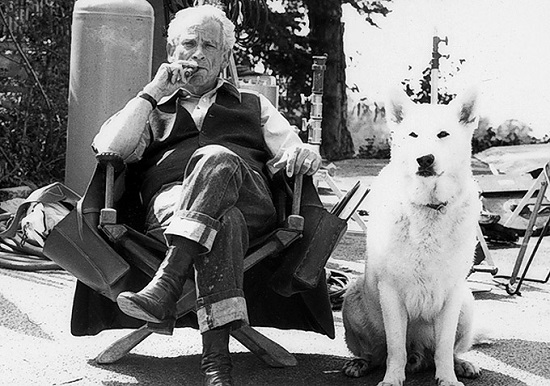For a man who predicted he would celebrate his 100th birthday, the American movie director Samuel Fuller spent a good deal of his life close to death. As a teenage crime reporter for the New York Journal, he covered executions at the infamous Sing Sing prison, where the spectacle of the electric chair horrified him to such a degree that he begged his editor to reassign him – to a different department, to a different story, hell, even to a hanging. "If you don’t like it, move to another state," his unsympathetic boss told him. He headed west to San Francisco, where the 1934 General Strike left corpses in the street and boosted the regional division of the KKK.
Later, as an infantryman in World War II, he saw action in North Africa and Sicily, before participating in D-Day and the Allied invasion of Europe. All along the way, he watched his friends get killed, did some killing himself, and witnessed horrors beyond anything he’d encountered on the crime beat. But none of that prepared him for what awaited at Falkenau, where US forces entered the concentration camps and for the first time Fuller realised the true extent of evil. His film camera was a constant companion, and Fuller documented many of the experiences which later had a profound influence upon his career as a movie maker.
Yet this proximity to death and violence never seemed to affect his own sense of immortality: indeed, his ability to emerge in one piece from WWII probably enhanced the belief he could control destiny. "We’ll have a big party for my 100th," he told his daughter Samantha. Fuller was overly optimistic in that regard, dying in 1997 at the age of 85, but in a directing career that encompassed several decades he exhibited a resolute disdain for Hollywood convention and its associated values, embarking in a direction that offered scathing social commentaries of 20th-century America. This was a man who had seen it all, yet little seemed to repulse him as much as establishment hypocrisy. Fuller’s rebellious instinct provoked and accused conservative America, and ensured he never received the studio backing his talent warranted. He would have it no other way, for Fuller’s forte lay with the marginalised and the abused, and portraying these groups on screen required total control. But while Fuller’s uncompromising pulp style and withering social analysis may have alienated mainstream audiences bred on the likes of Cary Grant and John Wayne, it crafted a legacy referenced by cinematic luminaries such as Martin Scorsese, Quentin Tarantino and Jim Jarmusch, all of whom have spoken of their high regard for Fuller’s nonconformist approach.
It is a memoir that Fuller posthumously narrates in the film A Fuller Life, as various associates from the world of movies read excerpts from his autobiography A Third Face, among them Jennifer Beals, Mark Hamill, James Franco and Bill Duke, in which every word, bar a brief introduction from Fuller’s daughter Samantha, who directed and produced the film, is composed by the man himself. It is an original yet faithful method, even if the temptation to mug for the camera while smoking a cigar – Fuller’s constant companion – does drift into the realms of ham once in a while (I’m looking at you, Wim Wenders).
But the opportunity to effectively hear directly from Fuller makes this a case in compulsion. Fuller grew up in an interwar era of skyscraper construction and street cars, of prohibition at home and expansionism abroad, as American cities soared from the earth and the nation began its ascent to becoming the most powerful in the world. Yet growth also brought inequality, and while Chicago and New York transformed into vast concrete citadels, the south was plagued by racism and poverty, where the KKK and its supporters terrorised and lynched their black neighbours. These contrasting sides to the American dream – opulence in the north and hatred in the south – made a big impression on Fuller, whose reporting immersed him in the conflicts taking place in the shadows of ivory towers. These early accounts, read by Franco and Beals, are interspersed with compelling footage of the era, as men in broad-rimmed hats strut down gleaming avenues and white-hooded children gaze upon burning crosses.
It is the film’s next section that is most remarkable. In 1941 Fuller joined the army, in his words, "to cover the greatest crime ever committed." Throughout his time in North Africa, Fuller documented his company on film, recording his comrades as they fought, rested and grew close, and presenting a more personal portrait of war than anything subsequently created in Hollywood studios. He filmed the liberation of Falkenau, where the furnaces and mass graves revealed the true extent of Nazi brutality. These experiences would inspire Fuller’s 1980 film The Big Red One, starring Lee Marvin and Mark Hamill, which strayed uneasily between humorous and harrowing, but which reflected a reality of troop camaraderie that veered suddenly into violence and despair.
In spite of Fuller’s fame as a cigar-touting maverick filmmaker, whose scathing criticisms of US society came to the fore in Shock Corridor and the banned White Dog (which seems relatively tame by today’s standards, apart from a misguided tutorial in attack dog training), it is his wartime experience that elevates this film. Samantha Fuller is aware of this, giving a large section of the film over to her father’s war footage, much of which was only discovered once production of A Fuller Life had already begun. Tim Roth, Perry Lang and Joe Dante are among those to animate Fuller’s story, yet their readings merely serve as a narrative thread along which to construct Fuller’s extraordinary images, which capture the nature of conflict as intimately as a family home movie.
Having spent so much of his early life in the presence of death, it comes as little surprise that conflict and abuse became defining elements of Fuller’s filmmaking career. If he was scarred by the horrors he had witnessed – not forgetting the gruesome spectacles at Sing Sing – he was also keenly aware of the absurdity of human violence and its desperate reflection of an illogical and blind collective mindset. Yet he was also a caring and concerned man, belatedly joining fatherhood at the age of 63, at which point he sought to readdress the chaos he had known with the role of a loving father, a task he took to with determination and joy. In A Fuller Life the overriding impression of Fuller’s autumn years is one of contentedness, as family life provided him with new purpose without blunting the causticity of his art. The accumulation of horrors that begot his formative education as a filmmaker makes it unlikely we will see his kind again.
A Fuller Life is showing at BFI South Bank and elsewhere



